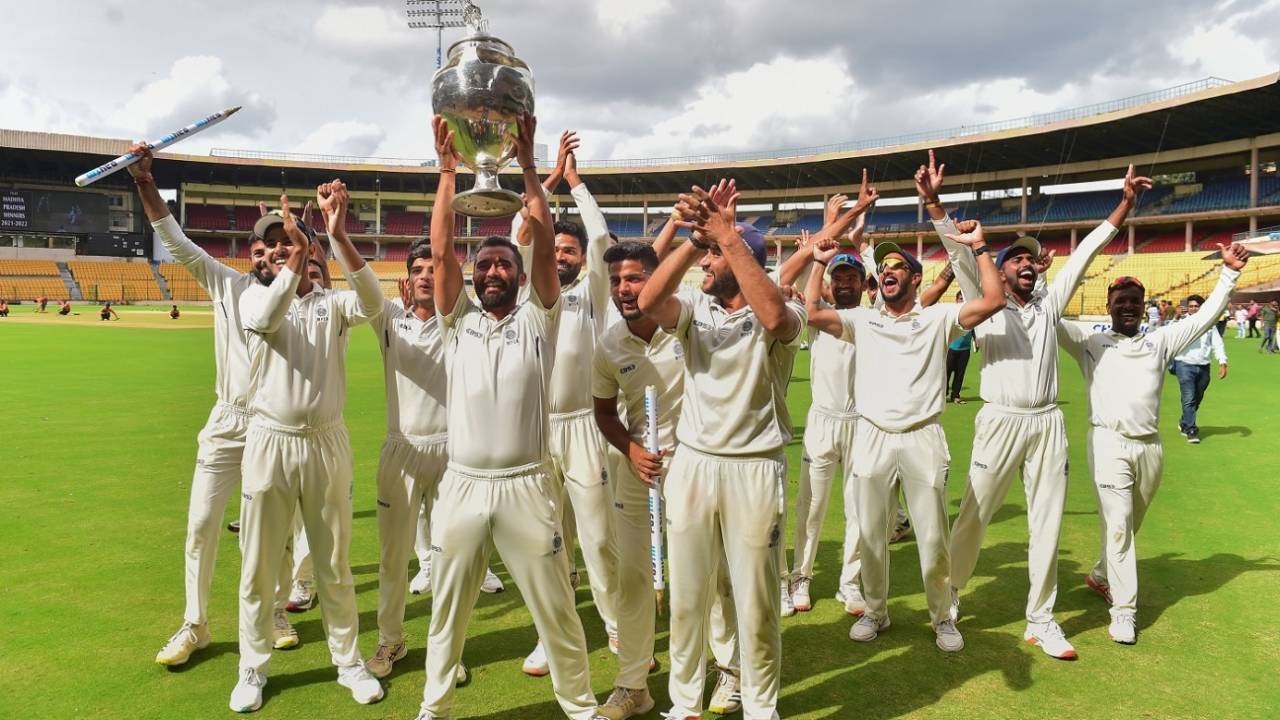So, the Ranji Trophy is set to begin on December 13. What's new?
For starters, we will have a full season, and not a curtailed one. Unlike in 2021-22, where the tournament was divided into two phases - pre and post-IPL - due to Covid-19, this one will run for 10 weeks starting Tuesday.
And is everything else apart from the format the usual?
Nope. The BCCI has tweaked it in an attempt to ensure the quality of its flagship first-class competition is not diluted. This time around, the tournament has been
split into two categories: Elite and Plate. Which means we'll also have two separate winners.
That sounds interesting. Can you tell us more?
Remember the pre-quarter-final last year, when Jharkhand amassed
a lead of 1008, the highest in first-class history, against Nagaland? Or maybe
Mumbai's 725-run win over Uttarakhand in the quarter-final, the biggest win in terms of runs in all first-class cricket? The BCCI is hoping we won't have such mismatches this year in the knockout stages.
Simply put, we will not have the Plate teams crossing over to take on the Elite teams during the knockout stages. Instead, they will play against teams at their level of competency, which the BCCI hopes would foster better competition.
Okay, two groups, two winners, and all that. But what is the format?
The top two from each Elite group, consisting of eight teams each, make the quarter-finals after an intensive league phase of equal home and away matches. In Plate, which is a six-team pool, each side plays the other five after which the top four make it to the semi-finals. The bottom two will feature in a playoff for fifth and sixth, while there will be another playoff for third and fourth. This way, they get to play the same number of seven league games like the Elite teams.
How do the Plate teams progress?
The two Plate finalists will be promoted to the Elite group for the 2023-24 season, while the bottom two teams of all the four Elite groups combined - factoring in both points and quotient - will be relegated.
Okay, now that the technicalities are out of the way, let's talk about players. Are there any big names in participation?
Well, yes.
Ajinkya Rahane is leading Mumbai, while
Ishant Sharma will be playing for Delhi. Suryakumar Yadav will be available for
Mumbai's second round game against Hyderabad. Cheteshwar Pujara will be available for the league phase after the first two rounds, which coincide with India's Test tour of Bangladesh.
Hanuma Vihari and
Mayank Agarwal, captains of Andhra and Karnataka respectively, will be looking to give their stalled Test careers another wind.
What about the newer players - who should we look out for?
Yash Dhull, among
Delhi's youngest captains, will be looking to build on an excellent fist-class initiation. While he could just manage 17 and 20 in his first India A stint in Bangladesh, he's racked up 820 runs in 13 innings, including four hundreds. Then there's
Yashasvi Jaiswal, fast emerging as a serious contender among the next-in-line openers. Like Dhull, he's had a great start. Coming off a hundred in Bangladesh for India A, he's taken his first-class tally to 1173 runs in 15 innings at an average of 83.78.
Among the fast bowlers, there's Bengal's
Mukesh Kumar who is potentially the closest to India selection among the next-in-line fast bowlers. Mukesh is currently injured with a hamstring strain and will miss the first two rounds, but his control and ability to deck the ball around has earned him plaudits from the outgoing selection committee. He was to replace Mohammed Shami in Bangladesh, but an injury on the shadow tour means the wait may extend a little longer.
Who are India's next spinners after R Ashwin, Ravindra Jadeja and Axar Patel?
For now, the selectors seem bullish on Uttar Pradesh's
Saurabh Kumar. The left-arm spinner has been in excellent form, picking up 15 wickets in two red-ball games with India A in Bangladesh, and is now
in the Test squad as a replacement for the injured Jadeja. Among the wristspinners, there's Kuldeep Yadav and Rahul Chahar. While there may not be an immediate requirement given India have four competent bowlers up top, they will eventually need to slowly start to look at life beyond Ashwin and Jadeja in the longest format. This Ranji season could throw up a few names.
Before you go, can you quickly recap who was the top run-getter and wicket-taker for the last two seasons?
Among Elite teams, Mumbai's Sarfaraz Khan
topped the charts in 2019-20, making 928 runs in nine innings at an average of 154.66. Overall that season, Arunachal's Rahul Dalal made 1340 runs to top the charts, he fell short of VVS Laxman's all-time record of most runs by 75 runs. Among the bowlers, Jaydev Unadkat's
record-breaking 67 wickets helped Saurashtra win the Ranji Trophy. Unadkat is now reaping the rewards of the good work over the past few seasons, having been
recalled to India's Test squad after 12 years.
In 2021-22, Sarfaraz was once again among the runs,
topping the charts with 982 runs in nine innings at 122.75, including a century in the final where Mumbai lost to first-time winners Madhya Pradesh. Mumbai left-arm spinner Shams Mulani
picked up 45 wickets to top the bowling charts.

